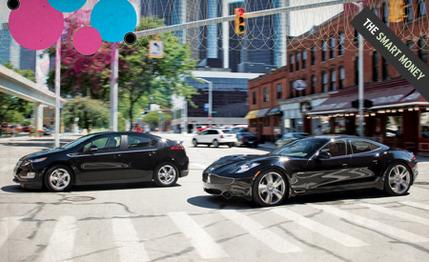
 Comparison Tests
Comparison Tests




At a glance, these two cars look vastly dissimilar.
One is mass market and utilitarian, the other a concept car rolling into the real world. Ham-radio operators drive the Volt. Justin Bieber drives the Karma. But underneath, the idea is pretty much the same—they are, for lack of a better term, practical EVs. Technically, the Chevrolet Volt and the Fisker Karma are hybrids, using both batteries and gasoline to effect locomotion via electric motors. Both cars run purely on electricity from the power grid as long as the battery packs hold juice. When the battery range ends, a gasoline engine powers a generator, freeing the driver from the tyranny of charging times and limited EV infrastructure. (The Volt also drives its wheels with its engine under specific circumstances.) The flip side to this arrangement is compromise. A smaller battery pack means less range than a pure EV, and the extra weight kills fuel economy when running in gas-burning mode. How these cars manage that compromise in achieving their eco-friendly missions is the crux of this story.


We’re looking for everyday EV practicality and driving dynamics as good as those of any conventional car. The Fisker, $111,000 as tested, carries an expectation of added performance and luxury. The $43,950 Volt does not. Costing 2.5 times as much as the Volt, the Karma better be damn sporty and luxurious.

